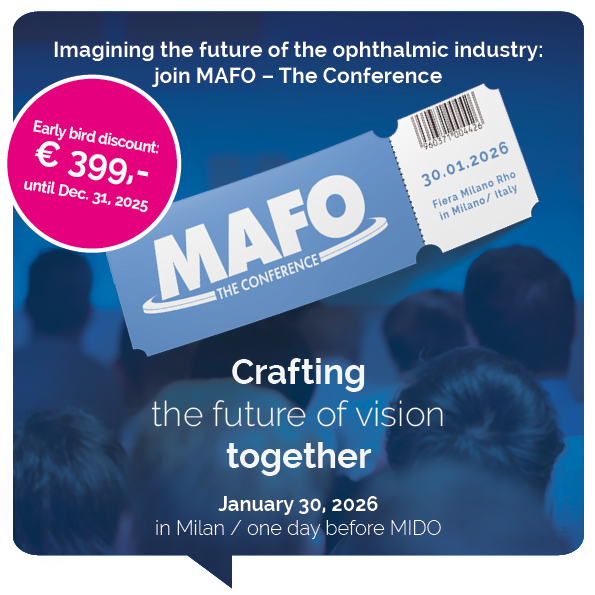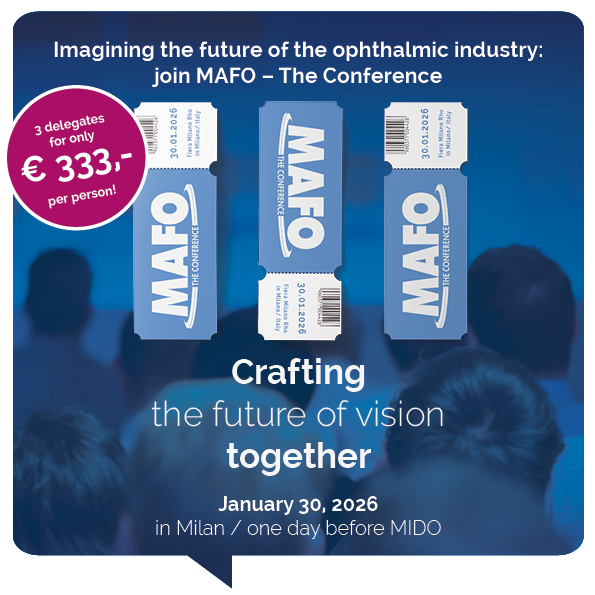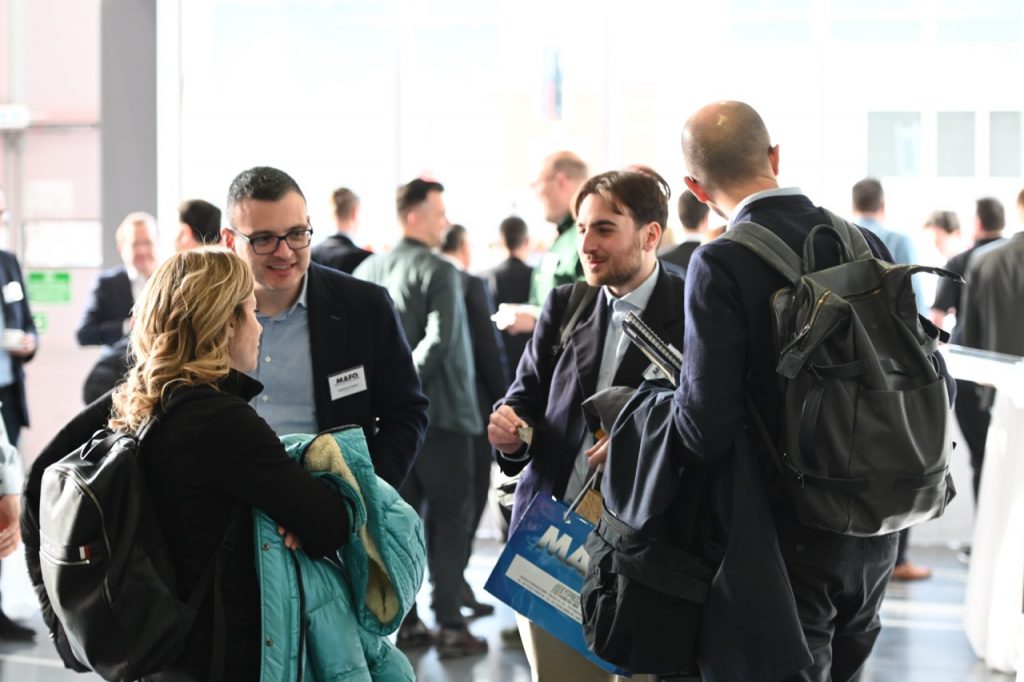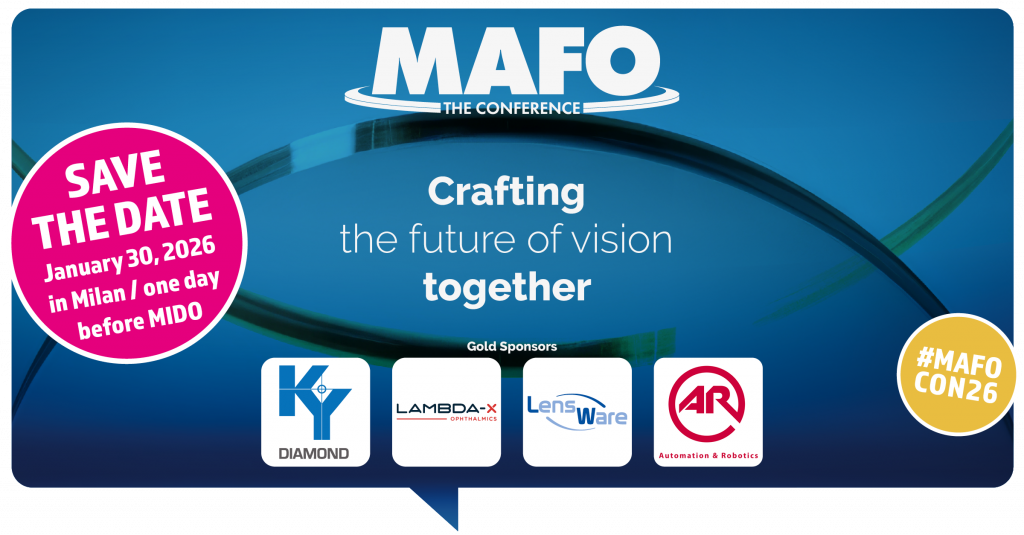
Save the date
When: January 30, 2026 (one day before Mido)
Where: Fiera Milano Rho, Conference center
Be always at the forefront of ophthalmic lens technology by participating in the 24th MAFO – The Conference. As the kick-off to the international trade fair Mido, the event attracts ophthalmic lens experts from around the world every year. MAFO – The Confrence offers a unique opportunity to exchange ideas with like-minded people in the ophthalmic lens industry and to stay informed about all the latest trends and developments.
- Autofocus glasses
- Additive manufactured spectacle lenses
- Smart glasses and myopia management
- Lens management systems
- Blockless manufacturing
- Market data, PFAS and more
our 2026 Speakers
- Niko Eiden
- Andy Huthoefer
- Alexandre Cormier
- Fabrice Bagnoud
- Roland Lorek
- Carsten Leutloff
- Bernd Freyermuth
- Arnaud Ribadeu Dumas
- Daniel Crespo
- Jose Alonso
- Dan Baker
- Simone Mangili
- François Van Lishout
- Sebastian Schneider
2026 Topics
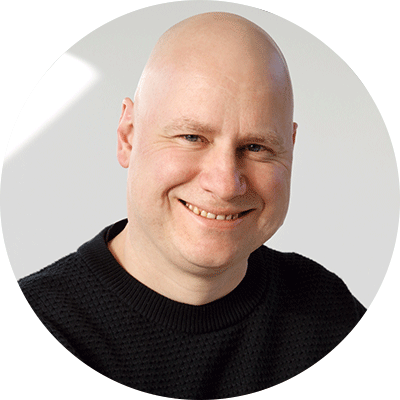
Niko Eiden
IXI Eyewear
Niko Eiden, CEO and co-founder of IXI, is pioneering the world’s first autofocus glasses, a breakthrough set to redefine a market unchanged for decades and irrevocably transform one of humanity’s most universal tools.
Drawing on over 20 years of experience in advanced optics, VR/XR hardware, and mobile imaging, Niko is driven by IXI’s mission to seamlessly improve vision correction and everyday life for glasses wearers with integrated technology that prioritizes user comfort.
At MAFO – The Conference, Niko will detail how IXI’s technology redefines ‘smart glasses’ and creates a new eyewear category by eliminating the limitations of fixed-focus lenses, focusing on genuine visual impairment solutions and implementing superior ergonomic features. Niko will also discuss IXI’s strategy to scale and deliver it’s autofocus glasses to opticians, exploring how this will reshape the global prescribing process.
Join us to discover how a blend of deep technological expertise and user-focused design is finally modernising the ophthalmic lens industry.
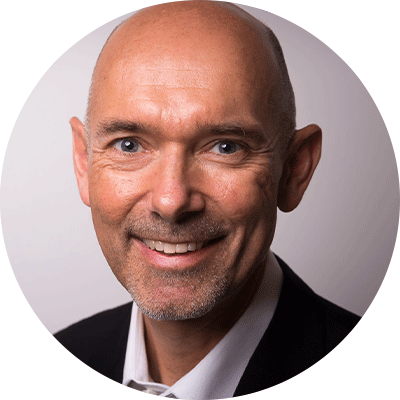
Andy Huthoefer
Satisloh
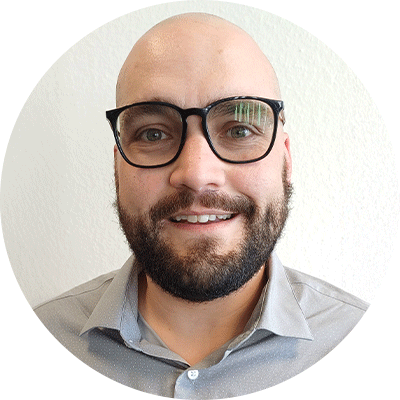
Alexandre Cormier
Satisloh
Currently, we block lenses so that they are held securely throughout all surfacing processes, don’t flex, and the front of the lens is protected. These are important functions. But if we can manage to do all this without blocks, that has a lot of advantages. It eliminates taping, blocking, deblocking and detaping. That makes the lens production process faster, saves space in the lab, drastically reduces the cost of consumables and is better for the environment. In this talk the presenters explain Satisloh’s new blockless surfacing technology and how it maintains compatibility with the full production range of lenses, a high throughput and impeccable lens quality. The resulting benefits for labs are detailed as well.
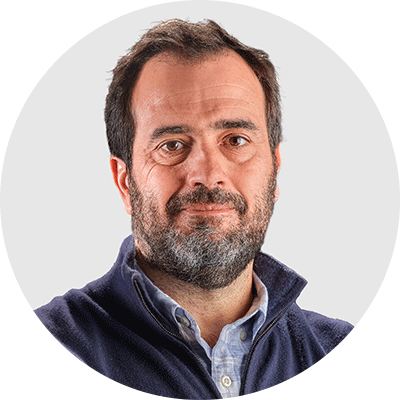
Dr. Daniel Crespo
IOT

Dr. José Alonso
IOT
The optical industry has long pursued digital additive manufacturing for optical elements, particularly ophthalmic lenses, which demand high customization. Success requires flexibility, simplicity, sustainability, and performance/cost parity or superiority over current free-form surface generation.
Light-Form Technology is the first approach with true potential to achieve these goals. It employs a novel volumetric printing process to polymerize the entire lens volume onto a substrate, which can integrate into the product or be removed and reused. This involves a single polymerization step using a precisely calculated, spatially incoherent radiation pattern to form a threshold surface separating polymerized and unpolymerized regions, this surface matching the desired lens geometry exactly.
Light-Form Technology is highly efficient: producing a complete lens in under three minutes without post-processing steps like homogenization or polishing. The current prototype achieves about one lens per minute and scales easily. It uses no water, consumes one-fifth the energy of traditional methods, and recovers unpolymerized resin – cutting polymer waste by 80%. It can produce any custom design, progressive or single vision.
This innovation could shift the paradigm in ophthalmic lens production, enabling thin optics for VR/AR devices, high-quality manufacturing in remote areas, and last-mile production in urban settings.

Arnaud Ribadeau Dumas
EssilorLuxottica
With over 50% of the world’s population projected to suffer from myopia by 2050, the need for accessible vision care has never been greater. Committed to playing a leading role in addressing this global health issue, EssilorLuxottica has been steadfast in its commitment to tackle this rapidly growing visual impairment and promote better eye health for future generations.
We believe that tackling this epidemic requires:
- Developing a comprehensive suite of myopia management solutions: solutions today include not only lenses which help significantly slow down the progression of myopia in children, but now also Smart Glasses that can track wearing time and patterns for more efficient and personalized myopia management
- Leading the global myopia conversation: sharing expertise and the latest insights, as an open network company
- Strengthening partnerships and supporting eyecare professionals: this includes providing ECPs with the latest evidence-based scientific, medical and clinical product knowledge to better support consumers.
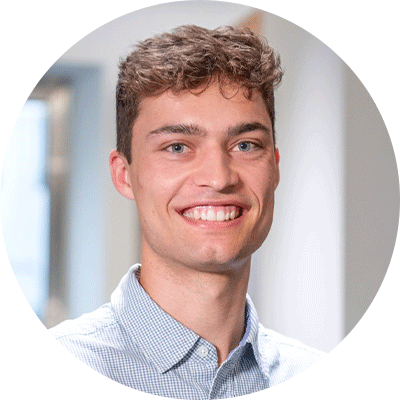
Fabrice Bagnoud
Solabs Nanotechnology
Solabs introduces the first thermal antifog solution (TAF by Solabs); a transparent, sunlight-activated antifogging coating that combines optical clarity with strong photothermal functionality. The design is engineered to achieve high absorption in the near-infrared (NIR) spectrum, which accounts for roughly half of the solar energy. Upon illumination, the absorbed NIR light is converted into heat, elevating the surface temperature and thereby suppressing water droplet nucleation and fog formation. As a result, the coating exhibits more than a fourfold enhancement in antifogging resistance and a threefold faster defogging rate compared to uncoated surfaces. The coating remains effective even under low sunlight intensities (as low as 0.2 suns) and can be fabricated using standard physical vapor deposition (PVD) techniques, such as e-beam evaporation or sputtering.
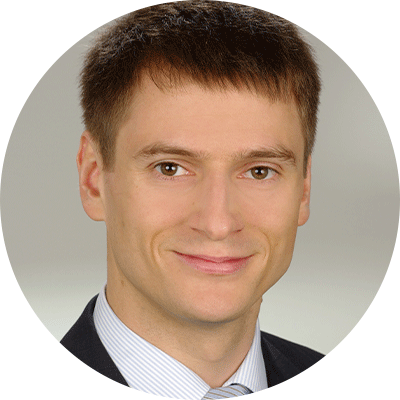
Roland Lorek
NielsenIQ/GfK
With the pandemic years behind us, Europe finds itself in times of growingly impactful structural changes: The war in Ukraine lasts on, well established industries struggle, inflation remains on an elevated level and affects the economic decisions of an ageing and only slightly growing population. The data from the GfK Consumer Climate Index show the attitude of European consumers towards major purchasing decisions. The NielsenIQ Optic panel gives insight into how the current purchasing behavior combined with the above-mentioned macro developments impact the European market for Spectacles. Combined, both data sources can serve as a basis for developing an understanding on where the market will go from here.

Carsten Leutloff
Spectaris
Spectacle lenses as medical devices are facing a pivotal change: the EU plans a comprehensive ban on PFAS in their manufacture, use, and placing on the market. The updated ECHA Background Document (20 August 2025) specifies concrete threshold values and indicates that no exemptions have so far been proposed for spectacle lens coatings. Equivalent alternatives are currently unavailable, and their development requires considerable effort. To safeguard quality, safety, and supply, the spectacle lens industry must actively participate in the second consultation phase and demonstrate that PFAS applications are technically necessary. Submitted information on uses, alternatives, socio-economic impacts, and enforceability will be crucial to ensure the continued availability of high-quality spectacle lenses.

Dr. Bernd Freyermuth
Lensware
The lecture will concentrate to evolute a template software architecture design of modern lab management systems. The architecture will show the different modules, linked together by a standard SQL database. Over many years, this architecture revealed well suitable to manage a standardized core, extended by customized functionality for the individual requirements of the single lab. Customization, total integration and migration, based on this core design, are the decisive elements of a modern LMS architecture.
The integral LMS should be able to manage end2end ophthalmic products (RX lens and Stock lens by pair, Stock lens also by bulk / wholesale), as well as trading articles (frames, accessories, consumables), in future in complex combination (packages), too.
The lecture will concentrate on discussing the core elements of the RX production unit, as well as the enhanded functionalities of Enterprise (ERP) and the WEB ordering feature. Integration into financial packages is mainly achieved by customization in format and communication, a standard solution should be part of the LMS sales modules (e.g. different eInvoice technologies).
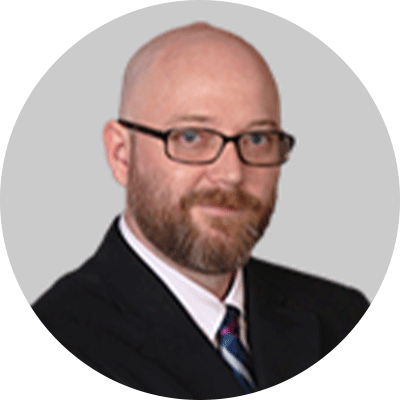
Dan Baker
Ocuco
Many optical labs still operate their LMS like it’s 1995, tracking jobs, printing tickets, and producing basic reports. Today’s labs face complex freeform designs, tighter SLAs, and multiple system integrations. The Lab Management System, Dan Baker argues, should coordinate that complexity rather than record it after the fact. His session presents the LMS as a production control layer that orchestrates workflow, protects data integrity, and reduces manual intervention. He details rules-based routing, scan-and-verify steps, and stable links to ERP, PMS, LDS, WMS, and shop-floor devices—measures tied to higher first-pass yield, shorter cycle times, and better promise-date adherence. The talk also offers an AI reality check: be “AI-ready” through sound engineering—clean signals, event logging, and exception handling—before advanced tools. Browser-based modules, he notes, enable effective oversight from anywhere. Attendees leave with a clear framework, practical KPIs, and next steps for scalable, measurable, data-driven operations.

Simone Mangili
MEI System
As the optical industry evolves through smart eyewear, automation, and changing consumer demands, technology providers are driving a new era of innovation in lens manufacturing.
By identifying both explicit and latent needs of ophthalmic labs, industry players are developing integrated solutions that consolidate multiple production steps, reduce transit time, and eliminate inefficiencies.
These advanced systems offer labs the Total Quality Control and real-time visibility over key performance indicators such as OEE and consistency in the output.
The result is simplified operations, lower costs, and consistently high-quality lenses. Through collaboration and data-driven development, the industry is empowering labs to meet future challenges and elevate the standard of vision care.

Dr. François Van Lishout
Automation & Robotics
The inspection of ophthalmic lenses is moving toward fully integrated systems capable of evaluating cosmetic appearance, optical performance, and coating quality within a single inspection machine. Advances in imaging, optical metrology, and AI-driven analysis now make it possible to reduce subjectivity, support operators, and achieve consistent quality across global manufacturing sites. This presentation discusses key trends shaping next-generation inspection systems, including improved repeatability, multi-modal measurement, and adaptive algorithms that learn from data rather than relying solely on fixed rules. It combines an overview of these technological directions with illustrative examples from industrial inspection systems, and shows how they enable more robust, scalable, and traceable lens inspection workflows for the eyewear industry.
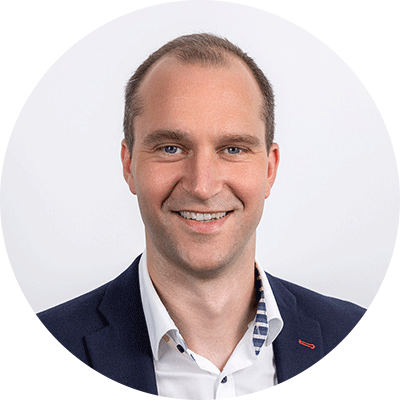
Sebastian Schneider
Schneider
In a rapidly evolving lab environment, edging technologies must meet new expectations. Next Gen edging outlines the key requirements shaping the future: higher effectiveness through reliable processing even under challenging conditions; greater efficiency with compact, high-throughput solutions; improved sustainability and enhanced serviceability thanks to cleaner, more accessible systems; intelligent smart functions powered by AI; and integrated quality control that elevates precision. This presentation provides a structured guide to these trends and offers orientation for labs aiming to stay ahead.

Award Ceremony
Presentation of the first MAFO – The Conference Audience Award for the best presentation
See on the next page, what we did in the past.

